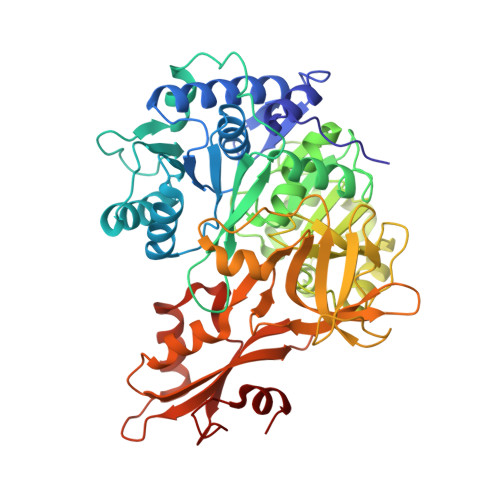Kinetically and Crystallographically Guided Mutations of a Benzoate CoA Ligase (BadA) Elucidate Mechanism and Expand Substrate Permissivity.
Thornburg, C.K., Wortas-Strom, S., Nosrati, M., Geiger, J.H., Walker, K.D.(2015) Biochemistry 54: 6230-6242
- PubMed: 26378464
- DOI: https://doi.org/10.1021/acs.biochem.5b00899
- Primary Citation of Related Structures:
4EAT, 4RLF, 4RLQ, 4RM2, 4RM3, 4RMN, 4ZJZ - PubMed Abstract:
A benzoate CoA ligase (BadA), isolated from the bacterium Rhodopseudomonas palustris, catalyzes the conversion of benzoate to benzoyl CoA on the catabolic pathway of aromatic carboxylic acids. Herein, apparent Michaelis constants K(app)cat and K(app)M were determined for an expanded array of 31 substrates chosen to systematically probe the active site architecture of the enzyme and provide a baseline for expansion of wild-type substrate specificity. Acyl CoA products were observed for 25 of the 31 substrates; in general, BadA converted ortho-substituted substrates better than the corresponding meta and para regioisomers, and the turnover number was more affected by steric rather than electronic effects. The kinetic data are interpreted in relation to six crystal structures of BadA in complex with several substrates and a benzoyl-AMP reaction intermediate. In contrast to other known natural substrate-bound benzoate ligase structures, all substrate-bound BadA structures adopted the thiolation conformation instead of the adenylation conformation. We also observed all the aryl carboxylates to be uniquely oriented within the active site, relative to other structures. Together, the kinetics and structural data suggested a mechanism that involves substrate binding in the thiolation conformation, followed by substrate rotation to an active orientation upon the transition to the adenylation conformation. On the basis of this hypothesis and the structural data, sterically demanding active site residues were mutated, and the substrate specificity was expanded substantially versus that of BadA. Novel activities were seen for substrates with larger substituents, including phenyl acetate. Additionally, the mutant Lys427Ala identified this nonconserved residue as essential for the thiolation step of BadA, but not adenylation. These variously acylated CoAs can serve as novel substrates of acyl CoA-dependent acyltransferases in coupled enzyme assays to produce analogues of bioactive natural products.
Organizational Affiliation:
Department of Biochemistry and Molecular Biology, Michigan State University , East Lansing, Michigan 48824, United States.















